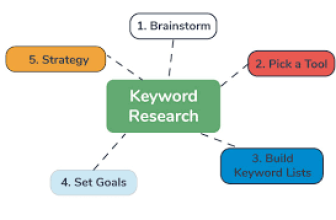Introduction
- Importance of SEO for blogging
- How headings improve SEO and reader engagement
Understanding the Basics of SEO
- What is SEO?
- Why does SEO matter for blogs?
The Role of Headings in SEO
- What are headings in blog content?
- The structure of headings: H1, H2, H3, and H4
Creating an SEO-Friendly Blog Outline
- Importance of structuring content
- Tips for brainstorming blog topics
How to Use Keywords in Headings
- Researching the right keywords
- Placing keywords naturally in headings
H1: Crafting the Perfect Blog Title
- What makes a great H1?
- Examples of engaging H1 titles
H2: Subheadings that Keep Readers Hooked
- Why subheadings are crucial
- Writing descriptive and keyword-rich H2s
H3: Breaking Down Your Content Further
- Organizing detailed information under H3
- Keeping H3 headings concise and clear
H4: Fine-Tuning the Details
- When to use H4 headings
- Adding depth without overwhelming readers
Common Mistakes to Avoid in Headings
- Overstuffing keywords
- Repeating the same headings
Tools and Resources for Better Headings
- SEO tools for keyword research
- Writing tools for headline analysis
Enhancing Readability with Proper Headings
- How headings improve user experience
- Balancing SEO with readability
Real-Life Examples of SEO-Optimized Blogs
- Analyzing successful blogs
- Learning from popular industry examples
Conclusion
- Recap of key points
- Encouragement to start creating SEO-friendly blogs
FAQs
- What is the ideal length for an H1 heading?
- Can I use emojis in my blog headings?
- How do I know if my headings are effective?
- Should I optimize headings for mobile readers?
- How often should I update headings for SEO?
The Ultimate Guide to Writing a Blog with Effective SEO-Optimized Headings
Introduction
Writing a blog that ranks well on search engines and grabs your readers’ attention can feel like a balancing act. SEO (Search Engine Optimization) is your ticket to getting noticed in the crowded online space. One of the most overlooked aspects? Headings. These simple lines not only guide readers through your content but also signal search engines about what your blog is all about. Ready to dive in? Let’s break it down.
Understanding the Basics of SEO
What is SEO?
SEO, or Search Engine Optimization, is the practice of optimizing your content to appear higher in search engine results. It’s all about making your blog easy for Google (and your readers) to understand.
Why Does SEO Matter for Blogs?
SEO brings traffic. More visitors mean more opportunities for engagement, sharing, and conversions. Without SEO, even the best content might remain hidden.
The Role of Headings in SEO
What Are Headings in Blog Content?
Headings are the titles and subtitles that organize your content. Think of them as signposts that guide readers through your blog.
The Structure of Headings: H1, H2, H3, and H4
- H1: The main title, used only once.
- H2: Major sections within your blog.
- H3: Subsections under H2.
- H4: Detailed points within H3.
Creating an SEO-Friendly Blog Outline
Importance of Structuring Content
An organized blog is easier to read and navigate, which keeps readers engaged and reduces bounce rates.
Tips for Brainstorming Blog Topics
- Start with a broad topic.
- Break it down into specific subtopics.
- Use tools like Google Trends for inspiration.
How to Use Keywords in Headings
Researching the Right Keywords
Use tools like SEMrush or Ahrefs to find high-ranking keywords relevant to your niche.
Placing Keywords Naturally in Headings
Avoid stuffing keywords. Instead, integrate them smoothly into your headings so they make sense to readers.
H1: Crafting the Perfect Blog Title
What Makes a Great H1?
A great H1 is concise, descriptive, and includes your primary keyword.
Examples of Engaging H1 Titles
- “10 Proven Ways to Grow Your Blog Traffic”
- “The Beginner’s Guide to SEO in 2024”
H2: Subheadings that Keep Readers Hooked
Why Subheadings Are Crucial
Subheadings break up text and make your blog scannable, catering to readers who skim.
Writing Descriptive and Keyword-Rich H2s
Include secondary keywords and offer a clear preview of what each section contains.
H3: Breaking Down Your Content Further
Organizing Detailed Information Under H3
H3 headings help expand on the points made in H2. Use them for step-by-step guides or detailed lists.
Keeping H3 Headings Concise and Clear
Avoid wordy phrases; stick to the core idea.
H4: Fine-Tuning the Details
When to Use H4 Headings
Use H4 for niche details or subpoints under H3, like this very section.
Adding Depth Without Overwhelming Readers
Make sure the text under H4 doesn’t feel redundant or excessive.
Common Mistakes to Avoid in Headings
- Overstuffing Keywords: Google penalizes keyword stuffing.
- Repeating the Same Headings: Variety keeps readers engaged.
Tools and Resources for Better Headings
- SEO Tools: Use Yoast SEO or Rank Math for real-time feedback.
- Headline Analyzers: Tools like CoSchedule analyze the effectiveness of your headings.
Enhancing Readability with Proper Headings
How Headings Improve User Experience
Clear headings make your blog skimmable and user-friendly, which improves dwell time.
Balancing SEO with Readability
SEO matters, but readability keeps your readers coming back.
Real-Life Examples of SEO-Optimized Blogs
Analyzing Successful Blogs
Visit popular blogs in your niche and study how they use headings.
Learning from Popular Industry Examples
Look at sites like HubSpot or Neil Patel for inspiration.
Conclusion
Headings are more than just a formatting tool; they’re a powerful way to boost your blog’s SEO and engage readers. By crafting clear, keyword-optimized headings, you’ll set your blog up for success. Now, it’s time to get started and let those headings shine!
FAQs
1. What is the ideal length for an H1 heading?
Keep it under 60 characters for readability and SEO.
2. Can I use emojis in my blog headings?
Yes, but use them sparingly and only if they fit your tone.
3. How do I know if my headings are effective?
Use headline analyzers and track your blog’s performance over time.
4. Should I optimize headings for mobile readers?
Absolutely. Short, scannable headings work best on mobile.
5. How often should I update headings for SEO?
Review and update headings every 6-12 months to stay relevant.







